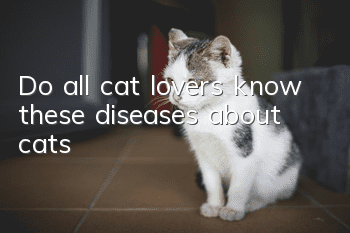Do all cat lovers know these diseases about cats?

Have some knowledge about cat diseases so that cats can receive better treatment
There are many diseases that cats can’t get by humans. Have you encountered this situation: your cat is feeling unwell and you take it to the hospital for a checkup. The doctor tells you that it has a disease that you have never heard of. I was very worried at the moment. At this time, if you have some basic knowledge about cat diseases, you will not worry about it in a panic. It can also prevent you from delaying medical treatment or seeing the wrong doctor due to your own random judgment.
Infectious enteritis
Causes and symptoms: This disease is caused by feline infectious enteritis bacteria that are excreted along with the feces, feces, saliva, and vomitus of sick cats. This bacteria is very rampant, can cause enteritis, and can also weaken the cat's resistance to other pathogens. Symptoms began with severe vomiting, persistent high fever, and almost no appetite. Once a baby cat is infected, it will gradually begin to have diarrhea and bloody stools. Death may occur within 3 to 4 days. If a pregnant female cat suffers from this disease, in most cases it will lead to miscarriage or stillbirth. So this disease is extremely scary.
Treatment and care: Supplement water and nutrition, and rely on the cat’s own strength to defeat the disease, which is more effective than medication. The best way to prevent this is to vaccinate your cat when he or she is young.
Viral rhinotracheitis
Causes and symptoms: This disease is commonly known as cat cold. It is caused by the sneezing of an infected cat and the herpes bacteria in the sick body. 4 to 5 days after infection, the cat suddenly developed symptoms such as malaise, fever, loss of appetite, and continued sneezing and coughing. Some cats also drool, shed tears, and suffer from conjunctivitis. This disease usually recovers immediately within two weeks, but if it causes other viral infections when the resistance is reduced, it will take a long time to be cured.
Treatment and care: Go to the hospital to clean the eyes and nose stained by secretions. Pay attention to keeping warm and quiet, and replenishing water and nutrition. Prevent bacterial infection. This disease can also be prevented through vaccination.
Cross viral infection
Causes and symptoms: This disease is caused by contact with sick cats and infection with influenza bacteria. Symptoms vary depending on the circulating virus. May exhibit symptoms very similar to those of bacterial rhinotracheitis. If it causes pneumonia, arthritis, oral ulcers, or intestinal infection, there will be no special symptoms. Pulmonary infections are the most terrifying. Pay attention when symptoms such as lying still, unsteady walking, or breathing occur.
Treatment and care: The main purpose is to help cats overcome the disease on their own. Therefore, pay attention to body temperature, moisture, and nutrient supply after the onset of illness. Also vaccinate them as early as possible.
WhiteBlood disease virus infection
Causes and symptoms: This bacteria is infected through the blood. However, since this bacteria is relatively weak, there is no need to worry as long as you do not come into contact with sick cats every day and are not infected due to injuries from fights. Once infected, it may cause leukemia and malignant tumors in the chest. Due to the weakened immunity, it is very easy to contract other diseases, and it is difficult to recover after being injured. There is always discharge from the nose, inflammation of the mouth, weight loss, whitening of the tip of the nose, lips, and tongue.
Treatment and care: Currently, there is no vaccine and no cure. However, taking appropriate measures according to the condition can prevent the condition from getting worse. The main method is to avoid contact with sick cats.
Infectious peritonitis
Causes and symptoms: This disease is caused by cat-infected peritonitis bacteria hidden in the sneezes and urine of sick cats. If the female cat is a carrier of the disease, it can also be transmitted to the baby through the birth canal. Once infected, the abdomen, pleural fluid, and tumors will appear in the abdomen. Pleural effusion will compress the lungs and cause difficulty in breathing. It may also cause systemic symptoms, such as listlessness, loss of appetite, fever, diarrhea, etc. If anemia and neurological symptoms appear, it means the disease has worsened.
Treatment methods: Since there is no effective vaccine, treatment methods that focus on alleviating symptoms can only be adopted. Do it consistently.
Virus infection with low immunity
Causes and symptoms: When cats bite each other, the bacteria are spread through the saliva of the carrier, so cats who don’t go out will not get this disease. About 1 year after infection, symptoms such as mild diarrhea, lymphadenopathy, and bacterial infection recurred. After a few years, it will cause chronic stomatitis, chronic oral ulcers and symptoms such as eye droppings, runny nose, fever and diarrhea. In the advanced stages of the disease, it will evolve into AIDS (acquired immunodeficiency syndrome), and the body will weaken rapidly.
Treatment and care: There is no vaccine for this disease, but if the correct treatment is taken before it turns into AIDS, it will not be fatal immediately. Adopting loose feeding methods at home can also extend its lifespan.
Pathogen infection
Causes and symptoms: The pathogen of this disease is a protozoan called Toxoplasma gondii that is widely found in animals, in the soil and everywhere in nature. Raw meat, feces of other cats, rats, cockroaches, etc. are used as transmission media. Adult cats do not develop any symptoms when infected. However, once a baby cat is infected, it will develop various symptoms such as fever, difficulty breathing, vomiting, diarrhea, jaundice, eye and nervous system abnormalities, and may be fatal.
Treatment and care: Due to the onset ofThe symptoms are very similar to those of other diseases, so it is difficult to distinguish them. Diagnosis can only be made through urine and blood tests. It is difficult to cure a baby cat after its condition worsens, so do not feed it raw meat, and pay attention to removing insects that may become vectors of transmission.
Infectious anemia
Causes and symptoms: This disease is also known as infectious feline anemia. The pathogen feline infectious anemia bacteria parasitize on red blood cells, destroy them, and cause anemia. Symptoms include the tip of the nose and gums being pale and bloodless, being out of breath and fainting when exercising. Fleas and other blood-sucking insects are possible spreaders of germs.
Treatment and care: Anemia can be cured by killing pathogens with antibiotics. However, if the immunity is low, the therapeutic effect may not be obvious. First, feed your cat nutritionally balanced food to build up its physical strength.
Fungal infection
Causes and symptoms: This disease is caused by infection with a type of mold. The mold, which is found in dried pigeon droppings, becomes airborne and can cause infection if it comes in contact with skin or is inhaled. However, healthy cats rarely become infected. If the respiratory organs are infected, it will cause runny nose, sneezing, and pneumonia; if the skin is infected, symptoms similar to ulcers and tumors will appear; if the eyes are infected, blindness may occur.
Treatment and care: You will not get this disease if your immunity is normal, so you must first cure the abnormal immunity. Since symptoms often begin with skin diseases, it is important to detect them as early as possible.
- What should I do if my cat likes to scratch the sofa?
- British shorthair cat feeding requirements
- Why does a cat lick its body like crazy?
- Will cats lose weight if their teeth are unhealthy? The reason why pet cats are getting thinner and thinner!
- What do kittens like to do in the sun during the day?
- Why does a cat pant so quickly?
- Why do cats catch colds repeatedly?
- The cat's tail stands up and curves into a hook
- Cat's tail raised
- How to train a kitten not to bite?



